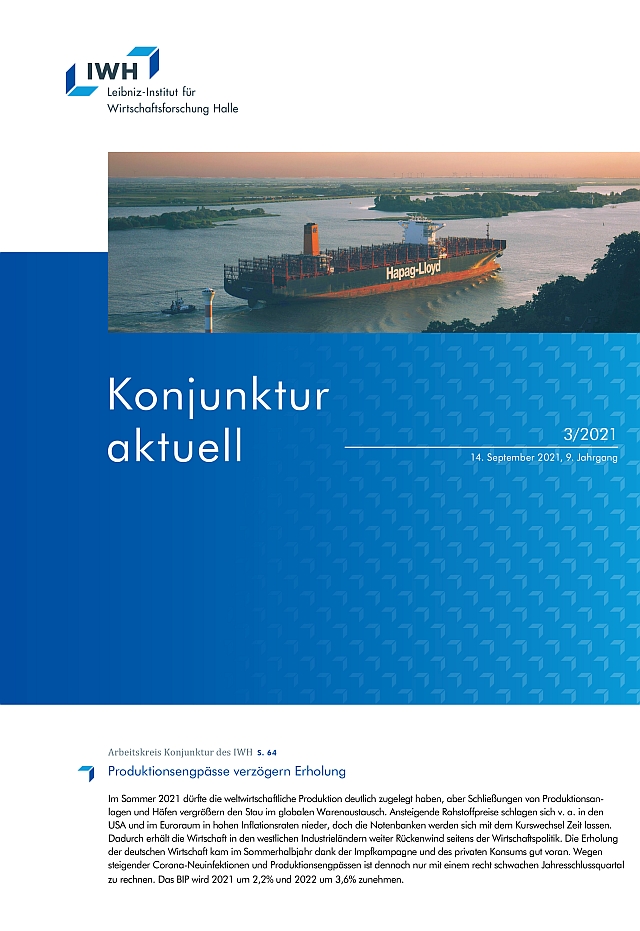Production bottlenecks delay recovery

Global economic production is likely to have increased strongly over the summer. Economic activity, however, is buoyant only in the advanced economies of the West. Waves of infections have recently weighed heavily on economic activity in large parts of Asia, where most of the people still lack full vaccination protection. In addition, the rise in commodity prices has caused rates of consumer price inflation to soar. Nevertheless, the U.S. Federal Reserve and the European Central Bank (ECB) will not abandon their expansionary courses any time soon. Thus, economic policy is still propping up Western economies. In other regions of the world, including East Asia, conditions are less favourable. In addition, constrained production capacities are likely to limit supply in the manufacturing sector into the year 2021.
In Germany, many restrictions on services have been eased during summer thanks to the vaccination campaign, and private household consumption picked up markedly in the second quarter. But private consumption is still well below pre-crisis levels, and a rapid recovery is not in sight given persisting supply restrictions in the manufacturing sector and rising infection rates. “However, it is likely that the recovery will gain momentum in 2022 again, partly because the situation on the labour markets is steadily improving,” says Oliver Holtemöller, head of the Department Macroeconomics and vice president at the IWH. Capacity utilisation is expected to return to normal by the end of 2022, especially as potential output is growing more slowly than before the crisis. Inflation will remain strong in the coming quarters, as CO2 prices are set to rise in 2022 and current shortages on the international markets are likely to ease only slowly. A sharp increase in the minimum wage will also put upward pressure on prices. Inflation is expected to reach 2.9% this year. With base effects waning, inflation will fall to 2.6% in 2022. The general government budget deficit is expected to be 4.5% of GDP this year and 1.3% in 2022.
One risk to the German economy arises from the dependence of German manufacturers on international value chains. According to Holtemöller, current disruptions are thus hitting the German economy particularly hard, and it is difficult to estimate when they will be resolved. The relative success in containing the pandemic, if compared to other European countries, is also posing a risk, as it implies low numbers of people who have achieved immunity after a contraction of the disease. The portion of vaccinated people in the population is probably too low to prevent a Corona wave in fall.
The extended version of the forecast (Konjunktur aktuell: Produktionsengpässe verzögern Erholung, in German) contains the following four info boxes (all in German):
Box 1: Assumptions and forecasts regarding the general conditions
Box 2: Latest revision of the national accounts
Box 3: Estimation of potential output
Box 4: Flood disasters and regional economic development in Germany
Publication: Brautzsch, Hans-Ulrich; Claudio, João Carlos; Drygalla, Andrej; Exß, Franziska; Heinisch, Katja; Holtemöller, Oliver; Kämpfe, Martina; Lindner, Axel; Müller, Isabella; Schultz, Birgit; Staffa, Ruben; Zeddies, Götz: Produktionsengpässe verzögern Erholung. IWH, Konjunktur aktuell, Jg. 9 (3), 2021. Halle (Saale) 2021.
Whom to contact
For Researchers

Vice President Department Head
If you have any further questions please contact me.
+49 345 7753-800 Request per E-MailFor Journalists

Internal and External Communications
If you have any further questions please contact me.
+49 345 7753-832 Request per E-MailIWH list of experts
The IWH list of experts provides an overview of IWH research topics and the researchers and scientists in these areas. The relevant experts for the topics listed there can be reached for questions as usual through the IWH Press Office.
Related Publications

Konjunktur aktuell: Produktionsengpässe verzögern Erholung
in: Konjunktur aktuell, 3, 2021
Abstract
Im Sommer 2021 dürfte die weltwirtschaftliche Produktion deutlich zugelegt haben, aber Schließungen von Produktionsanlagen und Häfen vergrößern den Stau im globalen Warenaustausch. Ansteigende Rohstoffpreise schlagen sich v. a. in den USA und im Euroraum in hohen Inflationsraten nieder, doch die Notenbanken werden sich mit dem Kurswechsel Zeit lassen. Dadurch erhält die Wirtschaft in den westlichen Industrieländern weiter Rückenwind seitens der Wirtschaftspolitik. Die Erholung der deutschen Wirtschaft kam im Sommerhalbjahr dank der Impfkampagne und des privaten Konsums gut voran. Wegen steigender Corona-Neuinfektionen und Produktionsengpässen ist dennoch nur mit einem recht schwachen Jahresschlussquartal zu rechnen. Das BIP wird 2021 um 2,2% und 2022 um 3,6% zunehmen.



